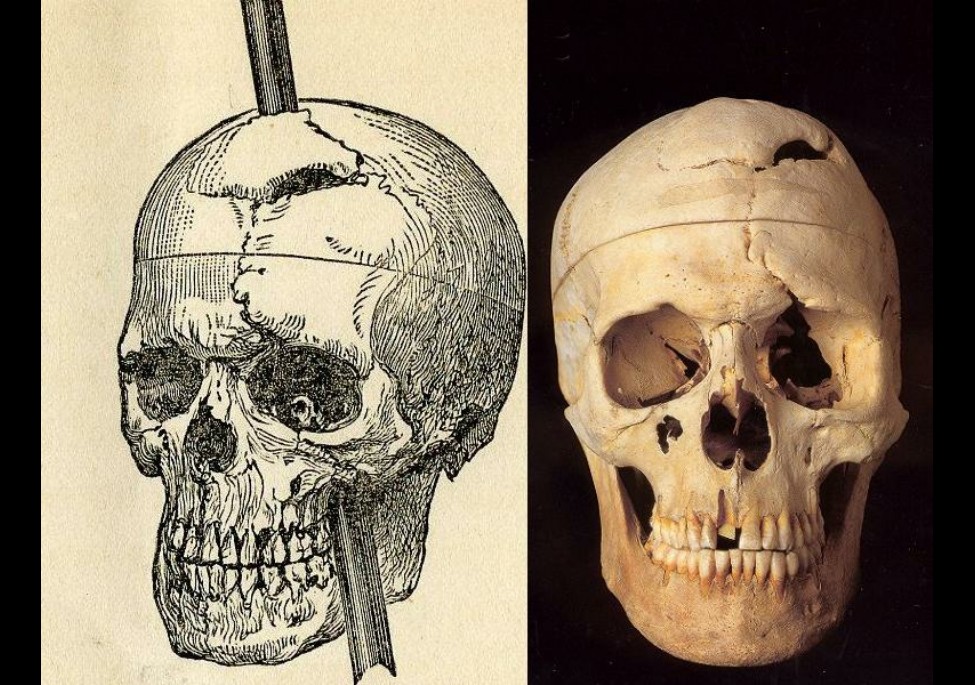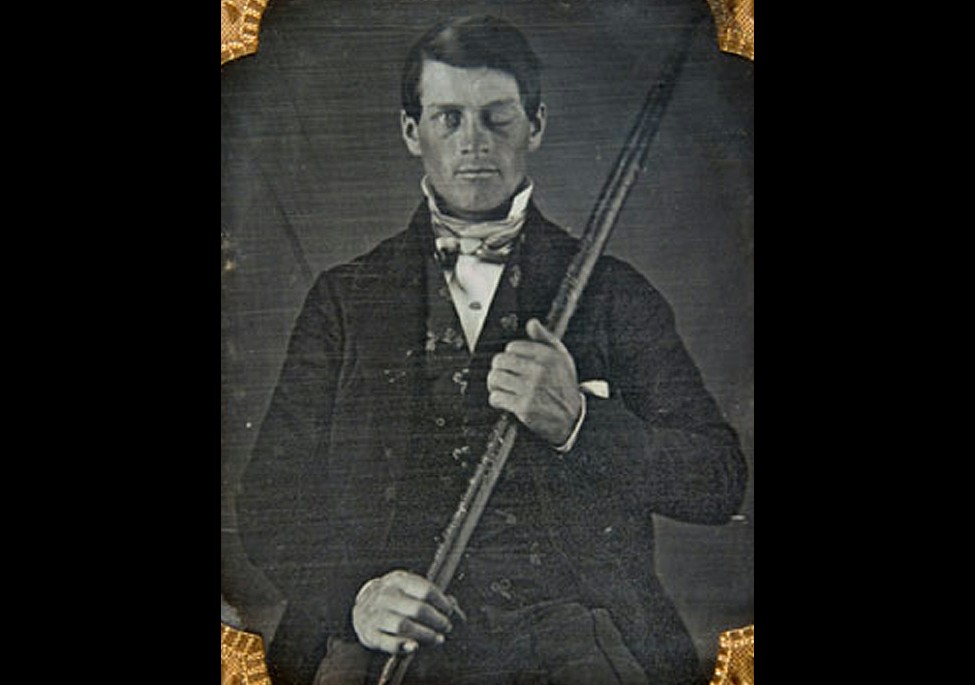
What) On September 13, 1848, 25-year-old Phineas Gage was foreman of a work gang blasting rock. After a hole was bored into a body of rock, one of Gage's duties was to add blasting powder, a fuse, and sand, then compact the charge into the hole using a tamping iron - a large iron rod. Possibly because the sand was omitted, around 4:30 PM: "the powder exploded, carrying an instrument through his head an inch and a fourth in diameter, and three feet seven inches in length, which he was using at the time. The iron entered on the side of his face ... passing back of the left eye, and out at the top of the head." Weighing 13 lb, this "abrupt and intrusive visitor" was said to have landed some 80 feet away "smeared with blood and brain.
Amazingly, Gage spoke within a few minutes, walked with little or no assistance, and sat upright in a cart for the 3/4-mile ride to his lodgings in town. The first physician to arrive was Dr. Edward H. Williams: "I first noticed the wound upon the head before I alighted from my carriage, the pulsations of the brain being very distinct. Mr. Gage, during the time I was examining this wound, was relating the manner in which he was injured to the bystanders. I did not believe Mr. Gage's statement at that time, but thought he was deceived. Mr. Gage persisted in saying that the bar went through his head. Mr. Gage got up and vomited; the effort of vomiting pressed out about half a teacupful of the brain, which fell upon the floor."
By November 25 Gage was strong enough to return to his parents' home in Lebanon, where by late December he was "riding out, improving both mentally and physically." In April 1849 he paid a visit to his doctor, who noted at that time loss of vision of the left eye, a large scar on the forehead, partial paralysis of the left side of the face and upon the top of the head...a deep depression, two inches by one and one-half inches wide, beneath which the pulsations of the brain can be perceived. Despite all this, his physical health is good, and I am inclined to say he has recovered. He has no pain in head, but says it has a queer feeling which he is not able to describe." In February 1860, Gage had the first in a series of increasingly severe convulsions, and he died in or near San Francisco on May 21 - just under twelve years after his accident.
It was not
until 1868 that Gage's doctor gave particulars of the mental
changes that Gage endured. In memorable language, he now
described the pre-accident Gage as having been hard-working,
responsible, and "a great favorite" with the men in his
charge, his employers having regarded him as "the most
efficient and capable foreman in their employ." But these same
employers, after Gage's accident, "considered the change in
his mind so marked that they could not give him his place
again": The equilibrium or balance, so to speak, between his
intellectual faculties and animal propensities, seems to have
been destroyed. He is fitful, irreverent, indulging at times
in the grossest profanity (which was not previously his
custom), manifesting but little deference for his fellows,
impatient of restraint or advice when it conflicts with his
desires, at times pertinaciously obstinate, yet capricious and
vacillating, devising many plans of future operations, which
are no sooner arranged than they are abandoned in turn for
others appearing more feasible. A child in his intellectual
capacity and manifestations, he has the animal passions of a
strong man. Previous to his injury, although untrained in the
schools, he possessed a well-balanced mind, and was looked
upon by those who knew him as a shrewd, smart businessman,
very energetic and persistent in executing all his plans of
operation. In this regard his mind was radically changed, so
decidedly that his friends and acquaintances said he was "no
longer Gage." (1)
Where) Phineas Gage's skull and tamping iron are at 10 Shattuck Street at the Countway Library of Medicine, on the 5th floor, in the Warren Anatomical Medical Museum. Open Mon - Fri from 9am - 5pm Free
Why) Pam
and I talk a lot about human behaviour and personality.
Although I never intended to go to the museum, our
conversation about the article above had the same effect as an
actual Buckys stop so it seems appropriate to include it on
the website. 




